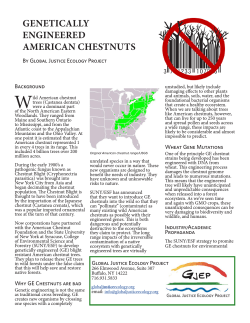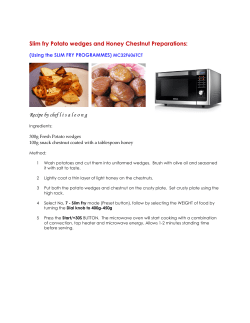
C h e s t n u t s
F E AT U R E Chestnuts Chestnuts Australia Inc Chestnuts are quite different from other nuts nutritionally and in a culinary sense. They have a sweet, nutty taste and a texture similar to a firm baked potato rather than a crunchy one. A standard serve of chestnuts is equivalent to about 30g or around four chestnuts. • A good source of low Glycaemic Index (GI) carbohydrate – chestnut meal has been GI tested and has a low to moderate GI value of 541 • Gluten free (GF) – while all nuts are GF, chestnut flour is a great replacement in baked products for those with Coeliac disease or gluten intolerance.2 Chestnut and other nut meals can help provide variety to the diet. Since GF diets tend to have a higher GI, nuts in general can help to lower the overall GI of these diets. • A source of dietary fibre – roasted chestnuts provide around 2g of fibre per 30g serve.3,4 This is particularly important for those with Coeliac disease who may not be getting enough fibre in the diet. • Low in total fat and saturated fat – chestnuts contain less than 1g of total fat per 100g, making them a tasty addition to a healthy, balanced, low saturated fat diet.4 • Source of vitamin C – chestnuts are the only nuts that contain vitamin C, with about 12mg in a 30g serve of raw product – 25% of the RDI for vitamin C. However the amount of vitamin C decreases by a third to a half after heating.5 Emerging research Like other nuts, phytochemical compounds are also found in chestnuts including phenolics (gallic and ellagic acid) with antioxidant and anti-inflammatory effects.6 Extracts from the inner chestnut shell, which is generally not eaten, is rich in antioxidants. Animal studies are showing interesting effects on carbohydrate absorption by acting as an alpha amylase inhibitor.7,8 Nutrient profile Nutritional analysis of roasted chestnuts4 Nutrient Per 100g Nutrient Per 100g Energy (kJ) 724 Folate (ug) 70 Protein (g) 3.4 Vitamin C 6 40 Fat, total (g) 0.6 Sodium (mg) 1.0 Fat, saturated (g) 0.1 Potassium (mg) 574 Fat, monounsaturated (g) n/a Magnesium (mg) 33 Fat, polyunsaturated (g) n/a Calcium (mg) 13 Carbohydrate, total (g) 34.3 Phosphorus (mg) 107 Carbohydrate, sugars (g) 3.8 Iron (mg) 0.8 Dietary fibre (g) 8.1 Zinc (mg) 0.5 Seasonality Chestnut season is from mid March to June when they are generally sold fresh. They are also available throughout the year as ready-peeled and frozen, flour, dried meal and sweetened puree. Storage DAA Member Newsletter April 2013 • To boil (if using to puree): place cut chestnuts into a pan of cold water, bring to the boil, cover and simmer for 15-20 minutes or until flesh is tender. When buying chestnuts, look for glossy nuts which feel heavy for their size, with undamaged, firm shells. Due to their high moisture content (they are almost 50% water) chestnuts can dry out easily. If storing them for more than a day or two, place in a plastic bag in the crisper section of the fridge to help retain their moisture. They should be stored as near as possible to 0°C. With proper storage, chestnuts can remain in good condition for a few weeks. Wrap the cooked chestnuts in a tea-towel for 10 minutes to provide steam- this helps with the peeling process. Then remove outer shell and inner skin while still warm (they’re tricky to peel once cooled). How to prepare and cook chestnuts 9 References If you have never had the pleasure of eating ‘roasted chestnuts on an open fire’, it’s time you tried them. Before cooking, cut the shell to prevent the nut exploding while cooking. Some people cut a slit across the face of the nut, others cut a cross into the flat-end. 1. International Diabetes Institute Glycemic Index Testing Service Chestnut Report August 2005. 2. Demirkesen I, B. Mert, G. Sumnu, S. Sahin. Utilization of chestnut flour in gluten-free bread formulations. Journal of Food Engineering 2010;101(3):329-336. 3. National Health & Medical Research Council. Nutrient Reference Values for Australia and New Zealand. Canberra, ACT: Australian Government Department of Health & Ageing 2006. 4. Nuts for Life. 2012 Nutrient Composition of Tree Nuts. Sydney: Nuts for Life; 2012. 5. USDA National Nutrient Reference Database for Standard Reference Release 25 cited March 2013. 6. De Vasconcelos MC, Bennett RN, Rosa EA, FerreiraCardoso JV.Composition of European chestnut (Castanea sativa Mill.) and association with health effects: fresh and processed products. J Sci Food Agric. 2010 Aug 15;90(10):1578-89 7. Tsujita T, Takaku T Mechanism of the inhibitory action of chestnut astringent skin extract on carbohydrate absorption. J Nutr Sci Vitaminol (Tokyo). 2008 Oct;54(5):416-21 8. Tsujita T, Takaku T, Suzuki T. Chestnut astringent skin extract, an alpha-amylase inhibitor, retards carbohydrate absorption in rats and humans. J Nutr Sci Vitaminol (Tokyo). 2008 Feb;54(1):82-8. 9. Chestnut Growers Australia website www. chestnutaustralia.com.au. • To bake: preheat oven to 200°C. Place cut chestnuts onto a baking tray and bake for 15-20 minutes or until the shell splits open. • To microwave: place cut chestnuts in a single layer on a microwave-safe plate. Cook, uncovered, on 850 watts/ high/100% for four to six minutes or until flesh is tender. • To roast, grill or barbeque: cook cut nuts, turning occasionally, in a pan over 16 medium heat for 20-30 minutes or until shell splits open. Links For further information on the nutritional benefits of nuts visit www.nutsforlife.com. au or for specific information on chestnuts go to www.chestnutsaustralia.com.au
© Copyright 2025











